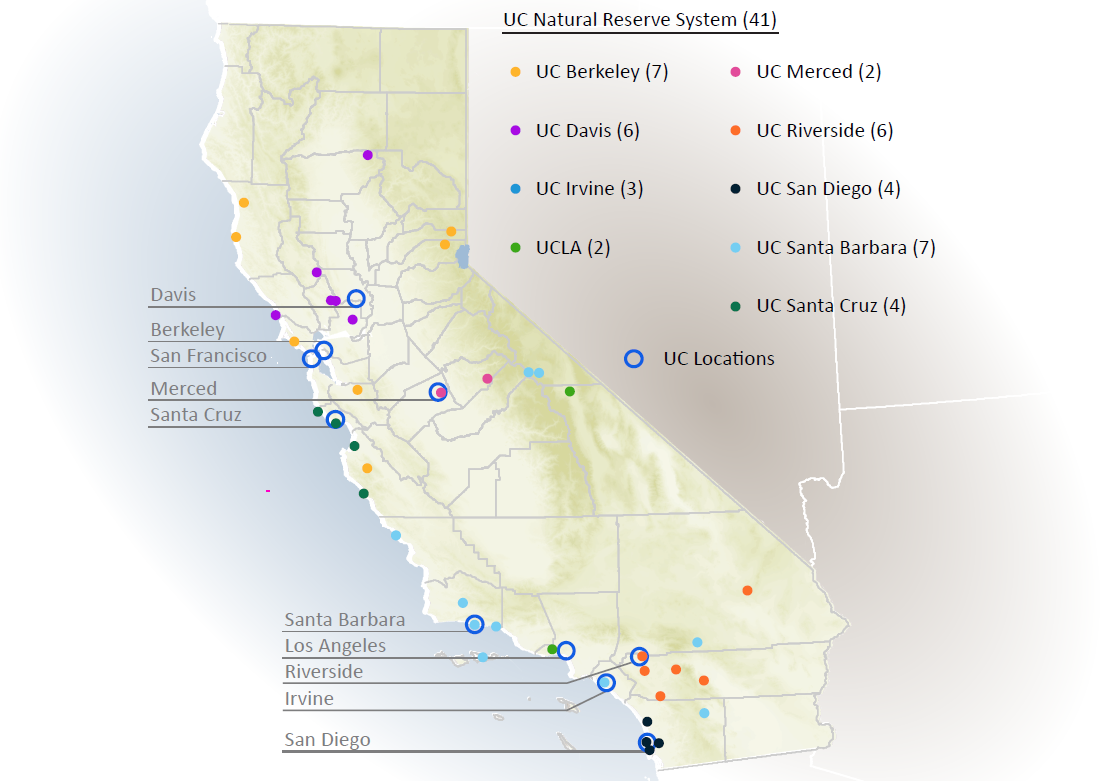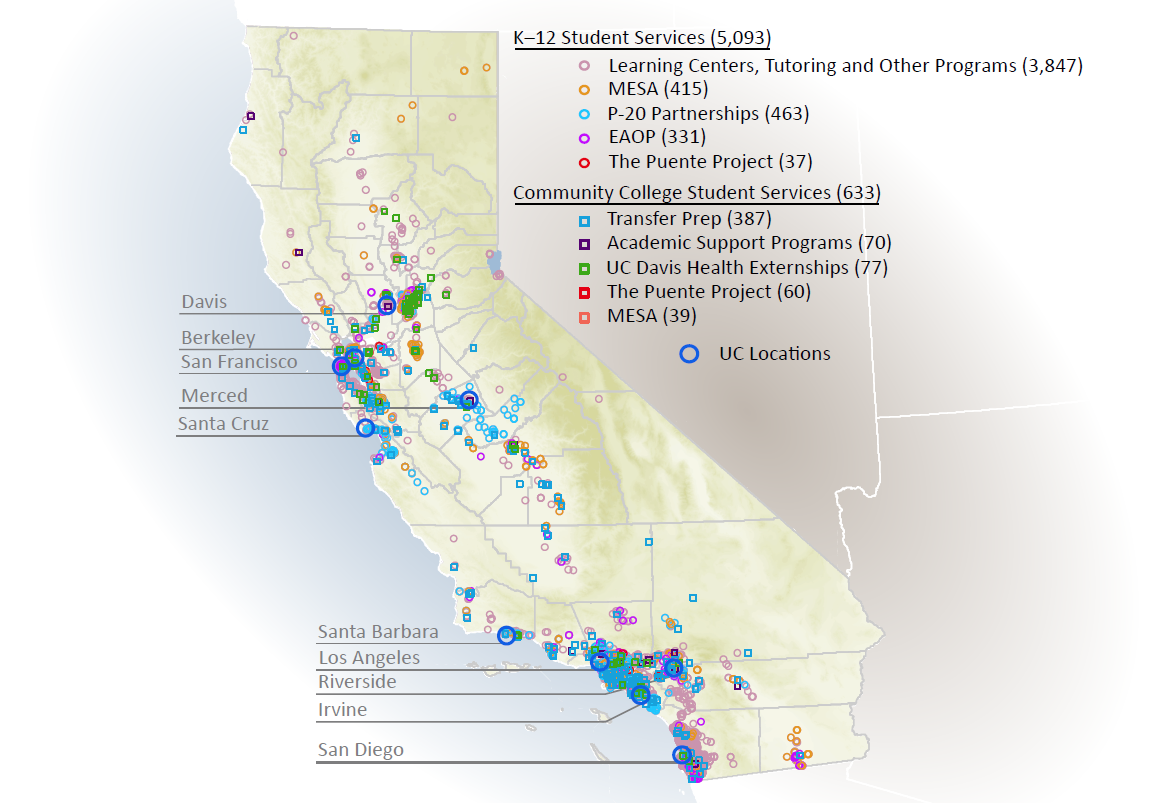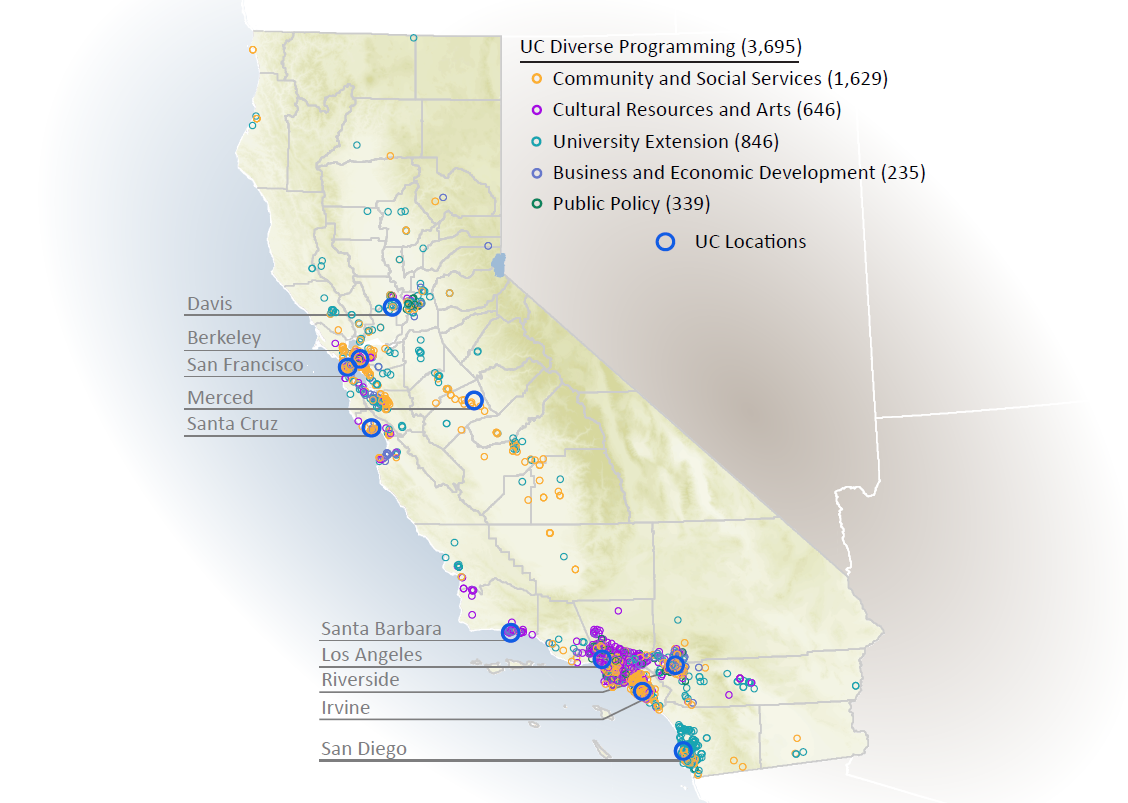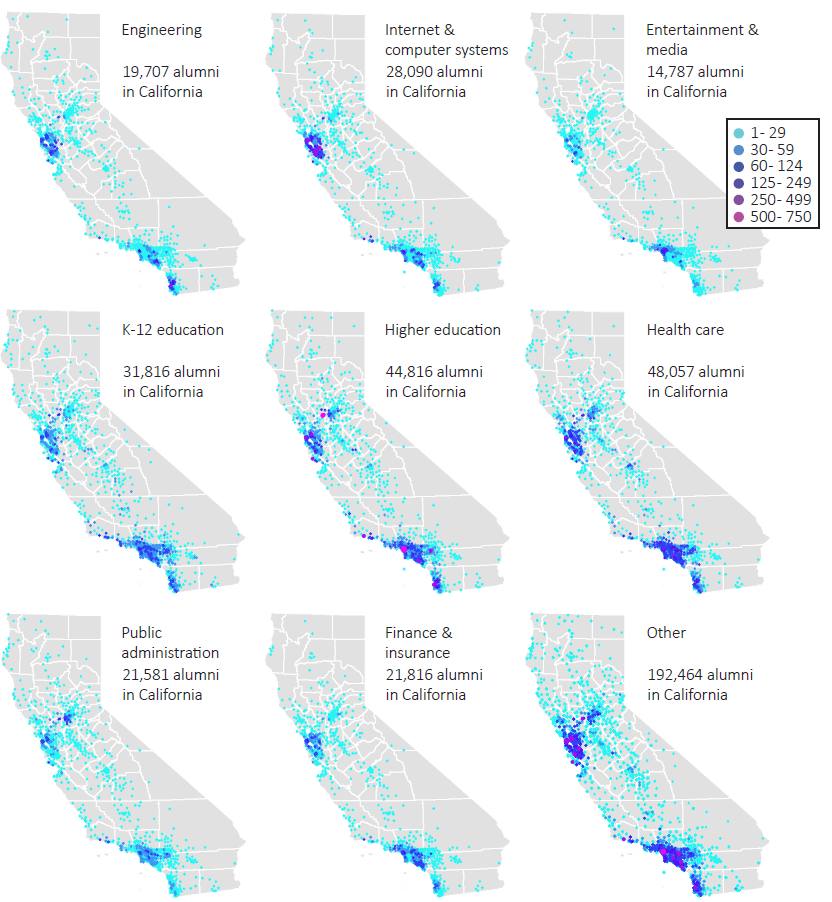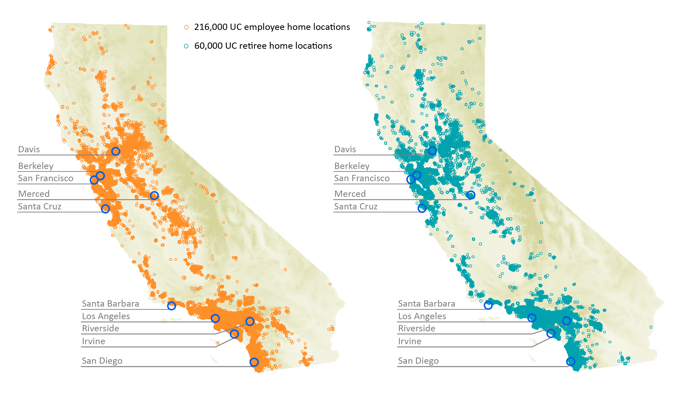Part of the UC mission
Along with teaching and research, UC contributes to the well-being of the state’s population and economic growth through its public service efforts. UC’s impact goes well beyond its on-campus activities. UC has a significant presence in nearly every community throughout California.
Educational outreach forms a crucial part of UC’s service to the state, including a network of world-class museums, libraries, herbaria, and other facilities open to the public for shared learning. Every UC campus administers hundreds or thousands of community-based programs across a range of foci, from the community and social services to teacher professional development and K–12 student services.
The University exhibits a steadfast commitment to public service in part through the support of sustainable agriculture, environmental stewardship, healthy families, and education. UC Agriculture and Natural Resources (UC ANR), the UC Natural Reserve System (NRS), the community-based programs of the Division of Diversity and Engagement, and all ten campuses are highlighted in this chapter.
UC Agriculture and Natural Resources
UC’s land-grant history
The Morrill Land-Grant Acts emphasized that the role of the University is to develop “useful and practical information … and to promote scientific investigations and experiments.” The Acts created a federal-state partnership for agricultural research and technology transfer. The University of California was chartered as California’s land-grant university. Subsequently, the Hatch Act of 1887 established state Agricultural Experiment Stations. In 1914, the Smith-Lever Act established Cooperative Extension services to extend university research through outreach and education. UC’s Division of Agriculture and Natural Resources is UC’s land-grant arm. State legislation incorporated county governments to become the third legal partner, such that today, UC ANR represents a three-way partnership with federal, state, and county governments.
UC ANR personnel and programs deliver resources from the UC system to Californians — even if there is no campus nearby. UC ANR forms teams, across UC and beyond, to develop innovative, multidisciplinary, science-based solutions to complex issues. UC Cooperative Extension (UCCE) is the education and outreach arm, serving all 58 California counties by bringing UC research to local communities. UC ANR’s mission is to engage UC with the people of California to achieve innovation in research and education that supports:
- Sustainable, safe, and nutritious food production and delivery
- Economic success in a global economy
- A sustainable, healthy, and productive environment
- Science literacy and youth development programs
UC ANR statewide network
UC ANR operates a statewide network of researchers and educators dedicated to the development and application of knowledge to address local agricultural, environmental, and health issues. This network of local UC Cooperative Extension sites and Research and Extension Centers (RECs) is often the face of the University to Californians with no other connection to the University. In 2020, 150 Cooperative Extension Advisors were conducting research, outreach, and education in all 58 counties from local UCCE offices. Nine statewide RECs provide education for the public and places for researchers to conduct field experiments. Approximately 565 Agricultural Experiment Station researchers are located at three campuses, and 120 Cooperative Extension Specialists are located at six campuses, RECs, and county offices. UC ANR maintains and enhances connections that engage UC with the people of California through more than 3,000 local partnership programs (10.1.1).
UC ANR’s statewide California Naturalist Program promotes stewardship of the state’s natural resources through education and service. The program delivery model involves partnering with around 50 well-established institutions to form a statewide network of organizations that offer the California Naturalist certification course. Since its inception in 2012, the program has certified over 3,770 graduates as California Naturalists who volunteer to support conservation and restoration efforts in 51 counties. In response to the 2020 national push for racial justice, the program re-examined its approach. As a result, the program is further emphasizing building meaningful relationships with organizations serving underrepresented groups and focusing on workforce development organizations; ensuring the relevance of program content, language, and delivery to diverse groups; increasing recruitment to those historically underserved by reducing barriers to access, including offering more scholarships; and taking responsibility for their own professional development and growth. In 2020, the program developed new partnerships with the following organizations serving underrepresented groups: Community Nature Connection, Nature for All, Outward Bound Adventures, and Southern California Mountains Foundation’s Urban Conservation Corps. In Southern California, the program has seen the largest growth in partnerships with organizations serving underrepresented groups. In the Central Sierra region, non-white participation has gone up from 20 percent in 2019 to 35 percent in 2020.
UC ANR’s UC Master Gardener Program extends to the public research-based information about food gardening and sustainable landscaping, including green waste reduction, pest management, water conservation, and pollinator-friendly gardens. There are over 5,900 UC Master Gardener volunteers in 50 California counties. In 2019, they donated close to 500,000 public service hours with an estimated value of $14.8 million. Participants reported adopting and improving gardening practices that protect natural resources and promote healthy people and communities on over 1.3 million square feet of homes, schools, and community gardens.
UC ANR’s statewide 4-H Youth Development Program uses a positive youth development framework and promotes experiential, inquiry-based science learning. In 2019 the program engaged over 155,000 youth aged 5-19 to help them reach their full potential, through working in partnership with over 14,500 caring adult volunteers. The annual statewide evaluation uses common measures; for example, in 2019, 96 percent of 800 4-H youth respondents reported they feel a responsibility to help their community, and 73 percent of 707 youth respondents in grades 8 to 12 reported aspirations such as studying science after high school.
UC ANR manages two statewide nutrition education programs: the California Expanded Food and Nutrition Program (EFNEP) in 24 counties, and the CalFresh Healthy Living, University of California (CFHL,UC) Program in 31 counties. EFNEP delivers research-based nutrition education to limited-resource families with young children to improve healthy lifestyle choices. In 2019, EFNEP reached almost 41,000 adult and youth family members. Evaluations of adult participants indicate 95 percent improved at least one diet quality practice, and 83 percent improved one or more skills for food safety. CFHL,UC operates under a joint agreement involving the USDA, California Department of Social Services, and UC Cooperative Extension to serve persons eligible for the federal Supplemental Nutrition Assistance Program. In 2019, in-person education was provided to over 97,000 participants. Furthermore, CFHL,UC policy, systems, and environmental interventions (e.g., smarter lunchrooms that influence healthy choices, food-based gardening, quality physical activity, wellness policies) were adopted by 397 partner sites, indirectly reaching over 176,000 individuals in early childhood centers, schools, and community environments.
The scope of UC ANR impact in response to the COVID-19 pandemic
UC ANR’s academics and programs, embedded in communities across the state in all 58 counties, responded quickly and creatively to the COVID-19 pandemic to meet their clientele’s new and ongoing needs under challenging circumstances. Given the severe economic effects of the COVID-19 crisis, California especially needs community economic development approaches to foster economic resilience and vigor across its working landscapes. With the COVID-related shutdowns and layoffs, UC ANR programs were a cornerstone for families’ food security and physical health. Below are examples of program outcomes that support the state’s economy, health, and environment in the face of the unprecedented pandemic.
Enhancing community economic development — UC ANR research and extension works with stakeholders to develop practices that increase the triple bottom-line: economic, environmental, and social. Multiple grants are available to growers to provide vital financial assistance, helping to absorb sales declines and increased marketing costs associated with the COVID-19 pandemic. However, some small farmers experienced barriers accessing these resources. UCCE in Santa Clara County provided technical assistance to 185 farmers from socially disadvantaged communities resulting in 155 being funded for a total amount of over $3 million in emergency relief during the pandemic.
Improving food security — In partnership with communities and allied organizations across the state, UC ANR conducts research to design and deliver educational programs that promote individual and community food security. UC ANR’s Nutrition Policy Institute (NPI) worked with eight school districts in California’s Central Valley to understand how school food operations pivoted during COVID-19. They distilled successes, challenges, and best practices for school districts and community partners to navigate emergent USDA policies related to serving free school meals during the pandemic. NPI's research influenced practice changes in several districts across the Central Valley region, for example:
- Parlier Unified improved school meal delivery logistics so that meals were accessible to families who lived far away from their children's schools. The district also provided culturally relevant foods such as tamales and jicama, which enhanced the appeal and healthfulness of meals;
- Fresno Unified streamlined meal service by offering multiple meals on one pick-up day instead of a daily meal, which increased their capacity to serve meals on weekends and holidays;
- Kings Canyon Unified streamlined their meal pick-up process and made phone calls to parents to remind them of meal distribution times, which increased participation in the program.
- These California-based innovative practices were amplified and disseminated through various national networks of child nutrition researchers and providers.
A UCCE Specialist in urban agriculture and food sovereignty provided training and technical assistance, at the UC Berkeley Gill Tract Community Farm, to local farmers on safe production and distribution during COVID-19. Two online training sessions helped farms stay open as an “essential business” to distribute food to community members who are food insecure. The UC Gill Tract Community Farm volunteers, including partners from Black Earth Farms and Sogorea Te Land Trust, organized a mutual aid food distribution program that produced and distributed tens of thousands of pounds of produce to over 30 local organizations and individuals, including the UC Berkeley Student Pantry, the Berkeley Food Pantry, and the Women’s Daytime Drop-In Center.
Improving drinking water safety — The UC ANR Nutrition Policy Institute (NPI) provided leadership through the National Drinking Water Alliance to ensure that the nation’s children have safe access to drinking water during the COVID-19 pandemic and beyond. A suite of checklists was developed for schools’ drinking water safety, access, and promotion. The Centers for Disease Control incorporated NPI’s recommended water safety practice language in a recent update of their COVID-19 water guidance for schools.
Improving health for all — A UCCE Nutrition Specialist at UC Berkeley led a literature review of scientific evidence and public health messaging on breastfeeding and providing prepared meals to individuals ages 65 and older during the COVID-19 pandemic. The breastfeeding educational materials were accessed more than 100 times by viewers located in northern and southern California, in other U.S. states, and Mexico and Ireland. The resource for nutrition programs serving aging adults was shared with the Alameda County Great Plates Delivered program, which then further extended it to the California Office of Emergency Services that tailored it for participating restaurants throughout the state.
Improving living and working conditions for California’s food system and farmworkers — UC ANR is working to help small farmers and farmworkers stay safe during the COVID-19 pandemic. UCCE in Fresno County distributed masks, hand-sanitizing wipes, and COVID-19 safety signage in multiple languages to roadside farm stands. Farmers were concerned both that they might lose customers under the shelter-in-place order and that customers might not follow COVID-19 safety procedures, possibly increasing the risk of COVID-19 spread to other customers or to the farmers and their family members. The Fresno County Fruit Trail commented on the safety practices adopted by the farm stands: “The health precautions taken provided a level of reassurance as they were able to efficiently serve a steady stream of customers (and customers queued up nicely with our masks).” In addition, UCCE in Santa Clara County distributed over 80 COVID-kits to farmers from socially disadvantaged communities to ensure worker safety. Through observations during farm visits, farmworkers started wearing masks when working, and through interviews, learned they were washing their hands more often. These practices ensure a safer working environment for farmworkers, protect workers’ health, and limit/slow the spread of COVID-19.
Increasing ecological sustainability of landscapes — In 2020, UC ANR conducted a collaborative research project on COVID-19’s impact on gardening, involving a team of researchers in Australia and Germany. A survey in English, German, Spanish, and Vietnamese was distributed in the three countries and received responses from over 3,700 gardeners. In the U.S., the UC Master Gardener Program was instrumental in circulating the survey to a state and national audience. Currently, the team is analyzing the survey data and preparing manuscripts for publication. Ultimately, this work contributes to knowledge about gardens’ role in community resilience to crises and about how to support gardeners under these difficult circumstances.
Improving animal management, productivity, and efficiency — California is the largest dairy-producing state in the nation, and dairy is the state’s top-producing commodity. While suffering from income losses and cash-flow constraints, the over 34,000 dairy farms nationwide must ensure the health and safety of their 150,000 employees, mostly of Hispanic ethnicity, who are considered essential workers. Recent U.S. statistics indicate that 30 percent of the reported COVID-19 cases were among Hispanics, even though they represent 17 percent of the U.S. population. A UCCE Veterinary Medicine Specialist at UC Davis conducted a COVID-19 needs assessment to understand how dairy producers, dairy workers, and allied dairy industry perceive the health and economic implications of the COVID-19 pandemic. This project conducted three nationwide surveys to reach three different stakeholder groups: dairy producers, dairy workers, and the allied industry. Summarizing and sharing the surveys’ findings with dairy producers are still underway.
UC Natural Reserve System
The UC Natural Reserve System (NRS) is a network of protected natural areas throughout California. These lands are managed for research, teaching, and public service, and are a major component of UC’s environmental stewardship. Its 41 reserves, which include more than 47,000 acres owned by UC, make the NRS the largest university-administered reserve system in the world (10.2.1).
As one of four trustee agencies recognized under the California Environmental Quality Act, the University of California holds reserve natural resources in trust for the people of the state of California. Reserve managers protect endangered plants and animals, restore native habitats, and control invasive species. Reserves also serve the public by holding lecture series, guided hikes, and other community events; by lending scientific expertise to conservation initiatives; and by hosting tens of thousands of California schoolchildren on field trips.
Most major state ecosystems are represented in the NRS, from coastal tidepools to inland deserts, oak savannas to offshore islands, and wetlands to Sierra Nevada forests. Reserves also serve as gateways to more than one million acres of public lands. NRS reserves include lands purchased by the University, donated by private landowners, and made available to the reserve system via partnerships with state and national parks, land trusts, and government agencies. Reserve amenities such as classrooms, lodging, laboratories, and internet access attract tens of thousands of users each year. These include researchers, students taking university courses, schoolchildren, and the general public. Those who seek to understand the workings of natural California come to the NRS to take classes, develop field skills, and conduct research.
More than 150 undergraduate courses across the UC system include visits to NRS reserves each year. Topics of study range from botany to zoology, archaeology to environmental planning, public health to the performing and visual arts. Scientists flock to reserves because reserve lands are protected in perpetuity. They feel comfortable launching long-term studies within reserve boundaries. Work at reserves produced more than 1,100 peer-reviewed journal articles between 2015 and 2020.
The emergence of the pandemic severely curtailed reserve use in 2020. In spring, most reserves limited class or public group use. Research visits were reviewed by campus administrators to ensure compliance with COVID-19 safety precautions. Visitor use of facilities remains limited. A handful of reserves had resumed minimal class use by the close of the year.
Despite these limitations, the NRS was able to expand its diversity and inclusion efforts by launching its Field Science Fellowship program. Geared toward students from ethnic and socioeconomic backgrounds traditionally underrepresented in the sciences, the program provided funding for four undergraduates to conduct full-time field research for a summer under the mentorship of a UC faculty member. In addition, a new study demonstrated that field courses, including the NRS’s California Ecology and Conservation program, dramatically improve academic achievement, major retention, and graduation rates among students who are from underrepresented minority backgrounds, are the first in their families to attend college, and/or face financial need (Beltran, R., Marnocha, E., Race, A., Croll, D., Dayton, G., Zavaleta, E. 2020. Field courses narrow demographic achievement gaps in ecology and evolutionary biology. Academic Practice in Ecology and Evolution doi.org/10.1002/ece3.6300).
The end of 2020 also saw the conclusion of the NRS’s five-year, 50 th Anniversary Capital Campaign. The campaign raised over $99 million from private philanthropy, government funding, and other sources of support.
More than fifty years after its inception, the need for the NRS has never been greater. Climate change, pollution, extinctions, and invasive species are fraying the fabric upon which life on Earth depends. By supporting university-level teaching, research, and public service, the NRS contributes to the understanding and wise stewardship of the Earth.
Educational partnerships
For nearly 50 years, the University of California’s Student Academic Preparation and Educational Partnerships (SAPEP) programs have helped prepare California students for higher education (10.3.1). Program activities are centered on student academic preparation, community college articulation support, school and community partnerships, and online and technology-assisted services. SAPEP programs served more than 210,000 K–12 students at more than 1,400 public schools and more than 28,000 students at all 114 California community colleges in 2018–19, the most recent year available.
The goal is to promote achievement by supporting academic preparation and college readiness. Programs include the Early Academic Outreach Program (EAOP), which focuses on “a–g” course completion (a prerequisite for admission to UC and CSU); K– 20 Regional Intersegmental Alliances (aka P– 20), creating ties between campuses, schools, local communities, and business organizations; The Puente Project, focusing on college-preparatory English skill development; Transfer Prep, focusing on community college transfer support; and Mathematics, Engineering, Science Achievement (MESA), focusing on STEM (science, technology, engineering, and mathematics) skills development.
The Mathematics, Engineering, Science Achievement (MESA) program integrates UC’s core missions of teaching and public service by focusing on the academic preparation of students at K–12 schools, community colleges, and four-year universities. Through its three components — the MESA College Prep Program (formerly known as MESA Schools Program or MSP), the MESA Community College Program (MCCP), and the MESA University Program (formerly known as MESA Engineering Program or MEP) — MESA serves more than 21,000 California students annually.

MESA College Prep centers are housed in 18 locations and serve more than 14,000 students at about 350 K–12 schools. Centers offer classes that reinforce math and science content standards. MESA activities include workshops aimed at strengthening study skills and monitoring progress.
The MESA Community College Program (MCCP) manages 40 centers at community colleges, serving around 4,000 students annually. These centers provide academic excellence workshops, orientation courses, academic advising, and counseling activities to help community college students transfer to a four-year university in a timely manner.
The MESA University Program operates 13 centers located in public (UC and CSU) and private universities across the state. Serving about 3,000 students annually, these centers assist college students in attaining four-year degrees in engineering and computer science by providing tutoring and academic skills workshops. In partnership with local industry leaders, MESA University Program centers also provide career and professional development opportunities for students. In addition to the activities UC undertakes to strengthen K–12 and community college students academically, UC plays an important role in preparing California’s teacher workforce. UC’s Teacher Education Programs prepare teacher candidates to engage students in rigorous, relevant, and inquiry-based educational experiences. Located at eight UC campuses, Teacher Education Programs recruit, prepare, and support educators who are committed to academic excellence, equity, and integrity, and to cultivating the highest levels of achievement and opportunity for all students.
UC also provides ongoing support to educators already in the workforce through professional development programs. For example, the California Subject Matter Project (CSMP) is a network of nine discipline-based statewide projects, providing more than 2,000 professional development events for educators at more than 10,000 schools each year. CSMP professional learning opportunities are aligned with state-adopted standards and are collaboratively designed by K– 12 and university educators to enhance learning for all students (10.3.2).
Social and economic impact
Including the programs of ANR, the Natural Reserve System, and UC’s educational partnerships mentioned above, the University of California administers more than 20,000 community-based programs across the state. Because the well-being of every California citizen and community is important, all campuses sponsor and manage programs far from their locations. For example, UC San Diego, near the southern border of California, runs clinical internship sites in Crescent City and other communities near the northern border of California; UC Davis, in the Central Valley, runs the Oiled Wildlife Care Network in Morro Beach on the central coast; and UC Santa Barbara, on the California Coast, runs the Outdoor Science Education Program in several locations on the east side of the Sierra Nevada range. All of UC’s community-based programs may be discovered and explored at: ucal.us/maps.
UC’s social impact
Through community and social services programs and cultural resources and arts programs, UC administers internship and field study programs that connect students and alumni with their communities; volunteer centers working on issues such as domestic violence, fair housing advocacy, and employment training; arts education and outreach programs that teach art, dance, drama, music, and digital arts in the community (10.4.1).
UC’s economic impact
Through business and economic development programs and public policy programs, UC facilitates internships offered in partnership with local companies, where students gain both UC credits and professional experience. Other programs bring local high-tech and green-tech companies together with motivated individuals to foster student participation in community economic development (10.4.1).
As California’s economy becomes increasingly dependent on highly educated workers, the role of the University of California in training the state’s future workforce becomes more vital. Industries relying on skilled workers in the STEM fields represent a major component of California’s economy. UC awards half of the state’s bachelor’s degrees in STEM fields.
More than 1.2 million UC alumni are known to live and work in California (10.4.2). They are leaders, volunteers, and contributors to the vitality of their communities, businesses, and culture. UC’s operations also add significantly to the state’s economy. With approximately 210,000 employees, UC is California’s third-largest employer (10.4.3). True to its land-grant mission, the UC system touches many aspects of life in California. The UC public service mission has evolved in tandem with the changing needs of our state and local communities and has developed programs and partnerships that improve the lives of all Californians.
For more information



